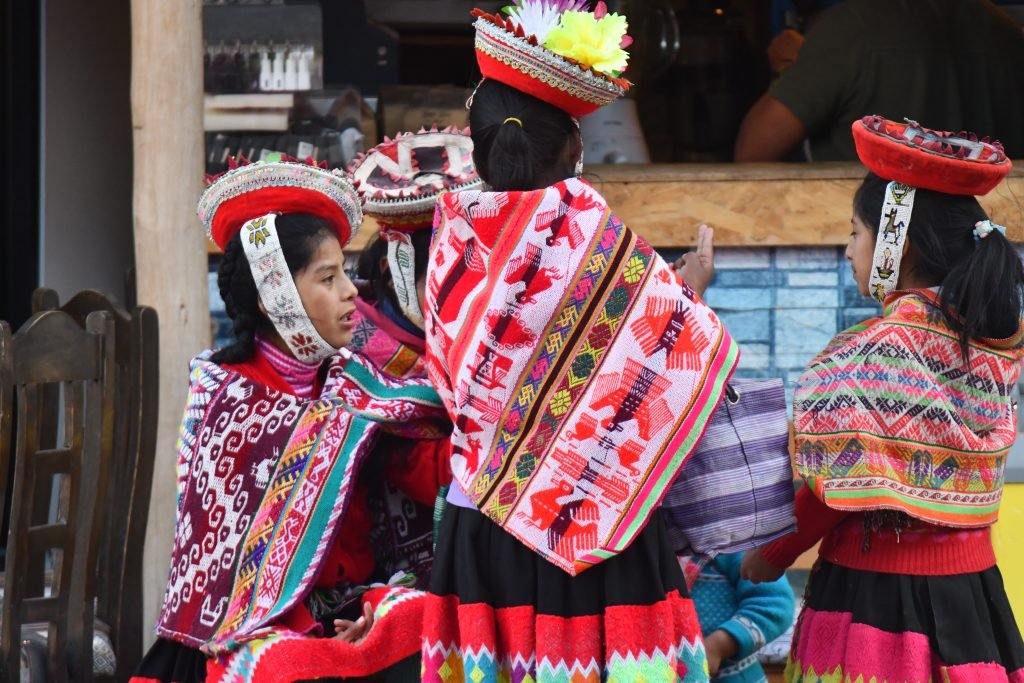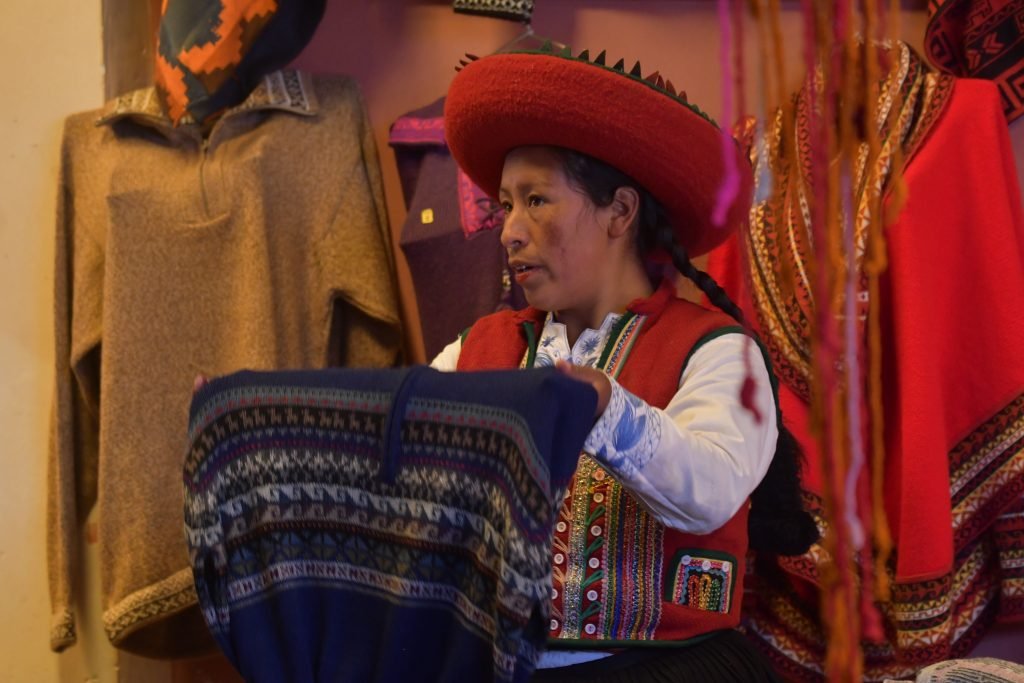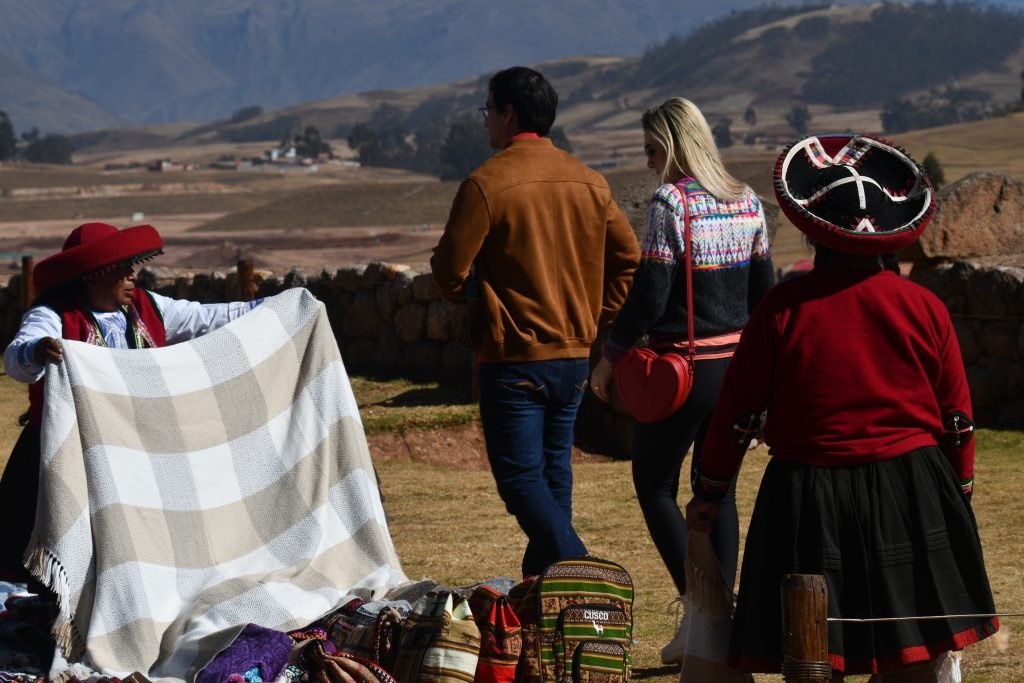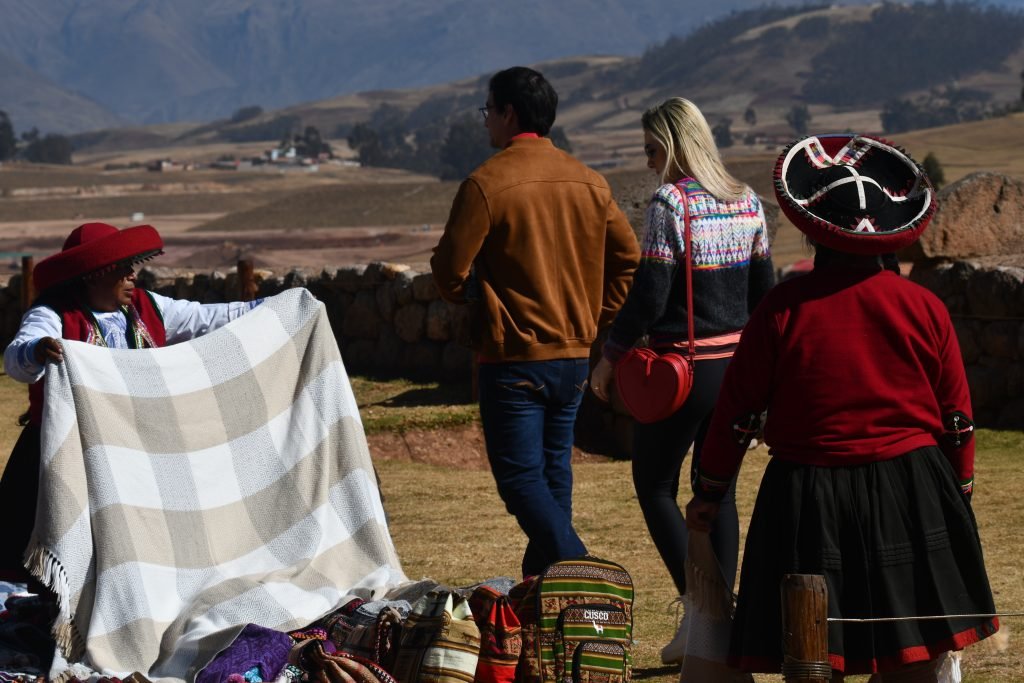Chinchero: Ancient Textile Traditions
You may already know that the Andean part of Peru stands out for its beautiful, intricate, and brightly colored textiles. These unique works give life and emotion to every Peruvian landscape, combining and contrasting with the natural colors of the surrounding land. Dating back to ancient times, Peruvians used to dye their textiles with local plants (and bugs!) Among them sheep, llama, and alpaca wool in every shade imaginable, they had an exceptional ability to bring out the colors in their textile art. The flag of the city of Cuzco, with the colors of the rainbow, is a testimony to the important role and impact of the impressive weaving born from the colorful resources of this land. From shearing to spinning, dyeing, and weaving, there is much to learn about Andean textiles and their complex and meaningful designs.

Weaving the tapestry of life
The traditional textiles in Chinchero Cusco, the mythical birthplace of the rainbow, and its surrounding weaving communities, an iconic town destined to be the most important center of Cusco textile manufacturing. Fiber works were discovered in the Guitarrero cave, in the high Andes of Peru, dating back to 8000 B.C., so it can be affirmed that this practice began in that period of time throughout the altiplano. Since then, the skill of the Chincherinos has flourished. The secrets of millenary techniques have been transmitted from generation to generation since those pre-Inca times. The Incas, in their time, came to value these detailed weaving as a symbol of wealth and status.
Today, the town’s talented artists are finally receiving the recognition they deserve as master weavers of the world. Hand-woven textiles from the Chinchero region are internationally recognized as priceless pieces of art and are exhibited in museums around the world. But the painstakingly woven textiles displayed in kiosks as you pass through town are not just a way of making a living. They are an integral and deeply rooted part of the community’s daily life and emotional interaction, a piece of these will not only bring back a beautiful souvenir of your visit but will manage to convey the emotions and feelings of an entire community that is steeped in history, traditions, and culture.
The girls watch as their mothers and grandmothers, master weavers with years of experience, patiently create these works of art, step by step. While out in the fields with the animals grazing, they are instilled in the arts of spinning wool. They learn simple patterns at an early age and then increase their talent and knowledge with guided practice in the sacred process of creation.
Within the society, the most respected are the best weavers, those who most skillfully express the traditions of their ancestors. Locals keep balls of hand-spun yarn from different periods of their lives and use it later to reminisce about their past and reflect on the experiences of each phase of their lives. Weaving is also considered a form of
form of quiet meditation, useful especially for older members of the community to forget everyday problems and be at peace.
Nilda Callañaupa, the founder of the Traditional Textile Center of Cusco, expressed her experience as follows: “I have learned that each piece of cloth embodies the spirit, skill, and personal history of an individual weaver.” He explained that “weaving is a living art, an expression of culture, geography, and history. It unites, with an endless thread, the emotional life of my people.”

The history surrounding traditions
Textiles in Chinchero Cusco is considered one of the most traditional villages in the entire Sacred Valley, it has the reputation of being a people rooted in their cultural identity that refused the conquerors (such as the Incas, the Spanish and modern man) to impose their traditions. The Inca Túpac Yupanqui, son of Pachacútec, developed the city as his personal residence, ordering the construction of a palace, sanctuaries, temples, baths, and terraces.
Chinchero was deliberately set on fire in 1536 by Manco Inca in his flight to Vilcabamba to prevent the Spaniards from obtaining supplies. The Spanish still built a colonial church and other structures in the city on Inca foundations. However, none of these conquering civilizations could take away Chinchero’s ancestral traditions and peculiar way of life.
Chinchero has always been known as the supplier of Cuzco, and it still is. Located at a higher altitude (3,760 m.a.s.l.) than the city of Cusco (3,400 m.a.s.l.), the Chinchero region specializes in the cultivation of potatoes, grains, cereals, and other tubers. Its wide skies covering the numerous cultivated fields and the surrounding snow-capped mountains of Veronica, Soray, and Salkantay make it one of the most picturesque places in the Cusco region.
Throughout all the changes and convulsions that this town has lived through for hundreds of years, textile art has been the common thread of every moment, constantly present in the daily life of its inhabitants.
The Process of the World’s Master Textile Artisans.

1. Shearing
The three sources of wool used in Chinchero are sheep, llamas, and alpacas. Local families are dedicated to raising these animals in the highlands around their homes. While llamas and alpacas are native to Peru, sheep were brought by the Spanish in the 16th century.
Each type of wool has its own use and texture. Llama wool is the coarsest, coarsest, and shortest of the three. It is used for everyday products such as ropes and sacks. Sheep wool is softer and finer than llama wool, but coarser than alpaca wool. It withstands dyes better than the other two and is sometimes preferred for the bright colors it can introduce into fabrics. Alpaca wool is the softest and most prized for fine fabrics and has several natural colors, such as white, cream, gray, brown, tan, and black. Cotton is not a traditional source of wool in the Andes.
2. Washing
After extracting the wool from the animal, it is sanitized. A local plant, the saqta, has a root that serves as a natural detergent when grated in hot water. What a great way to clean these precious fibers! To remove all traces of soap, dry grass can be passed through the wool.
3.- Spinning
Once the fibers are clean, they have to be spun. In Chinchero no machines are used for this process. Instead, the weavers use a traditional pushka, a small drop spindle. Girls begin practicing with the pushka as young as 5–6 years old. It is a delicate skill to perfect. This task can take about 60% of all the time it takes to create a finished product, between spinning and double-ply spinning (twisting the fibers together after the first spin), actually through their manual work they can observe all the performance it takes to make a product and notice the quality of traditional manufacturing.
4.- Dyeing
Dyeing natural wool with natural products found in the environment is something very special to witness. Unfortunately, this ancestral tradition was lost for about 100 years with the introduction of synthetic dyes, but since then it has been recovered, and today it is back in full force. Now, the most sought-after fabrics are those that are actually produced naturally with the magnificent colors of the earth. The following are the resources used in the natural dyeing process in Chinchero.
Nowadays, Day, along with their meanings:
Greens Nature, Ch’illca Leaves.
Blue Sky Quinsa K’ucho leaves & Tara pods Reds Blood – Life Insects Cochineal
Yellows Fire Q’olle flower & Yanali bark Purple Nobility Purple Corn & Awaypili
To change the pH of the solution and obtain different shades of each color, weavers add lime juice or salt to the mixture. Traditionally, even urine from children under 2 years of age was used to
children under 2 years of age to make the colors adhere to the fabric, as well as collpa, a mineral from the jungle.
After preparing the dye, the wool is boiled with it for 30–60 minutes, depending on the desired shade, and then hung to dry on the rails for 2 days.
5.- Warp
In this step, the weaver establishes the size and shape of the finished product, as well as the colors and designs to be used. The passive and vertical threads of the weave are stretched and fixed on a wooden frame that will hold the thread in place while the weaver works. There are two main types of warps used in Chinchero: back strap looms (one end is wrapped around the weaver’s waist and the other is attached to a tree or pole) and four-pole looms (created by driving 4 wooden or metal poles into the ground to create a rectangular frame).
This is one of the most special steps in the manufacturing process since, being a process shared by 2-3 people, it is a social activity among family, friends, and community members, as well as productive and creative. The weaving process is considered sacred and often includes prayer and a traditional “pago a la tierra” or payment to Mother Earth, offering the fermented Andean corn drink (chicha), coca leaves, or other sacred objects to the earth, requesting blessings on the project under development.
6.- Weaving
Finally, undoubtedly the most artistic part of creating a unique textile! Once the vertical threads have been secured in the warp stage, it is time to add the active horizontal threads that will give the textile its final colors and designs. In Chinchero, the technique of weaving on the warp side is used, creating two-sided and reversible pieces, neither of which shows the “leftover” threads from the weaving process, definitely a work of art.
In larger weavings, such as shawls (iliklla) and blankets, a common design is the luraypu, a symmetrical, vertical design formed by stripes of solid colors between threads of interwoven linear designs and then sections of traditional figures, such as animals, nature, people or gods. The final and unique piece of any Chincherino weaving is the characteristic and intricate tubular border called ñawi awapa. It is the most beautiful part of any weaving. Practical and decorative at the same time, it adds character and a finishing touch to the whole.
Chinchero weavers make many different products, such as chullos, wide-brimmed hats, scarves, gloves, socks, sweaters, table runners, tapestries, ponchos, bracelets, blankets, shawls, belts, wallets, pillowcases, rugs and skirts.
Want to see it in person?
The best way to create unique and quality memories in Peru, with the best guidance and guaranteed fun for your whole family, is to book an excursion to the Sacred Valley during your stay in Cuzco, including a visit to a textile workshop in Chinchero. For a more in-depth and hands-on cultural experience, you can look for a homestay or a multi-day interactive workshop in one of the 10 weaving communities of Chinchero, this intercultural experience is one of the best you can find in Peru, not only will you get to know one of the cradles of Peruvian tradition, but you will interact with their direct descendants who continue to practice these traditions themselves.
If you are impressed by their skill and talent, be sure to support these local artists by purchasing beautiful one-of-a-kind pieces to take home or give as gifts to family and friends. Know that your purchase is creating a sustainable lifestyle for hundreds of families here in the Peruvian Andes – you’ll be helping to improve the quality of their lives!
Before you leave, be sure to check out other Cusco day trips and then explore the best things to do in Peru!





